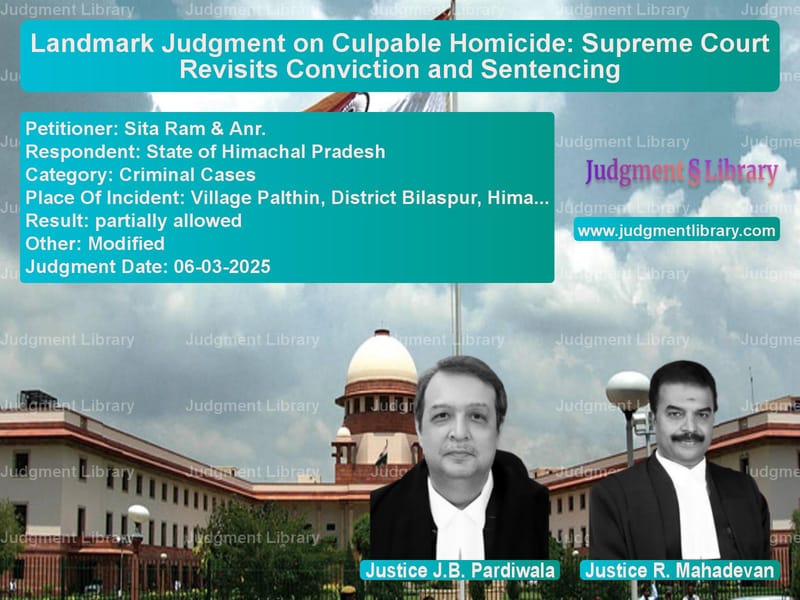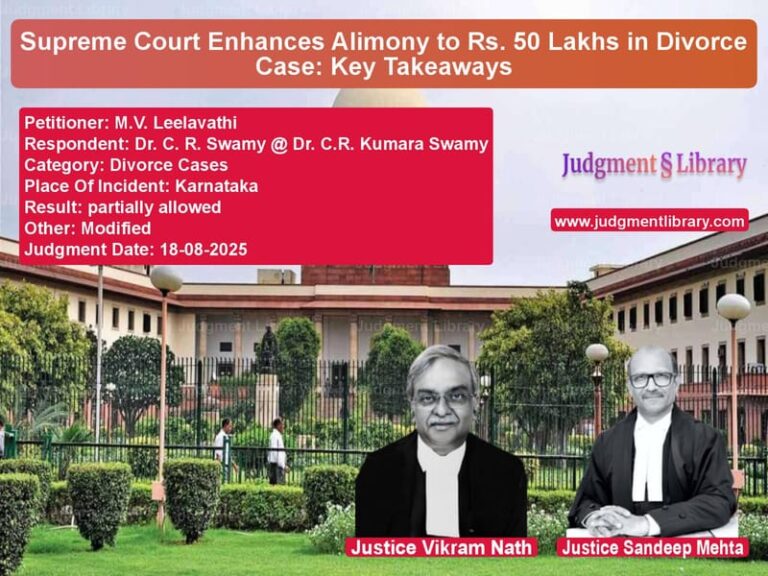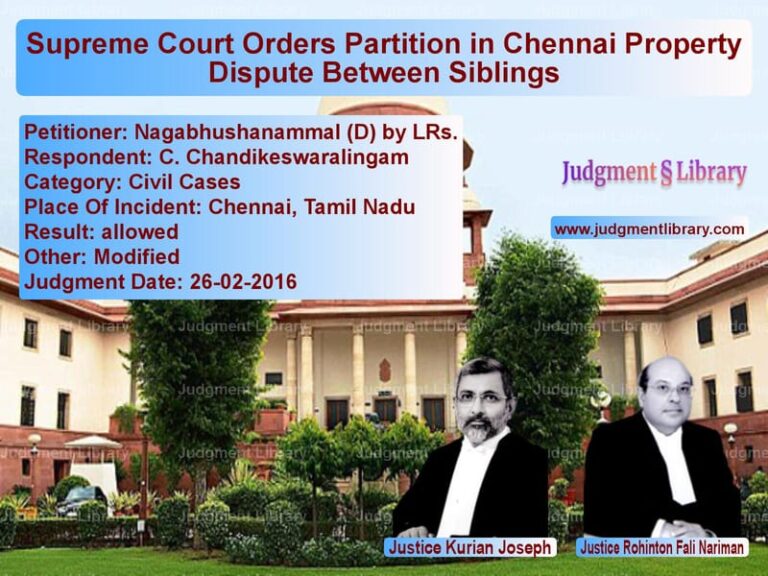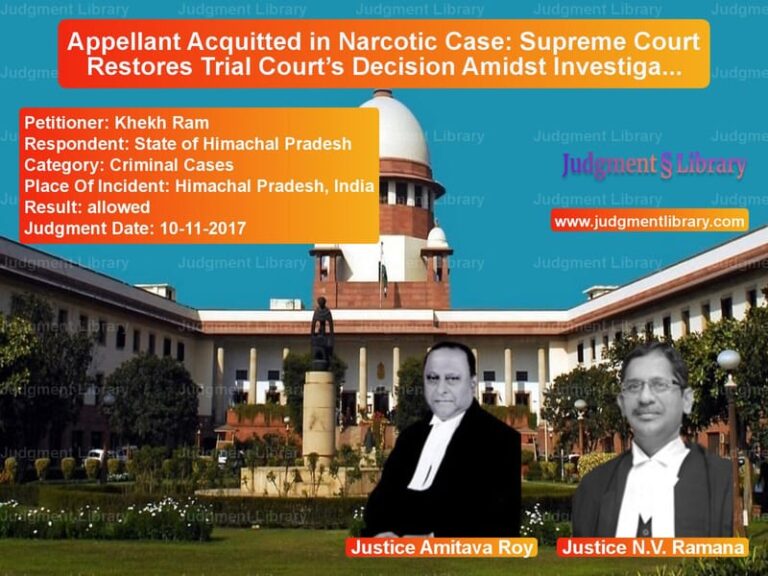Landmark Judgment on Culpable Homicide: Supreme Court Revisits Conviction and Sentencing
In a crucial ruling, the Supreme Court of India adjudicated the criminal appeal in the case of Sita Ram & Anr. vs. State of Himachal Pradesh, addressing the issue of culpable homicide and the evidentiary value of a deceased’s statement under Section 32 of the Indian Evidence Act. The decision, authored by Justices J.B. Pardiwala and R. Mahadevan, examined whether the appellant’s conviction for culpable homicide not amounting to murder under Section 304 of the Indian Penal Code (IPC) was justified and whether the statement made by the deceased in an FIR could be treated as a dying declaration.
The case involved a fatal altercation between the deceased, Prem Lal, and the appellants, Sita Ram and Onkar Singh. The prosecution alleged that the appellants trespassed into the deceased’s house and assaulted him, leading to severe head injuries that eventually resulted in his death due to asphyxia.
Background of the Case
On the night of November 16, 2000, Prem Lal was involved in a quarrel with his brother, Pyare Lal, regarding a pile of cow dung. Following the argument, Pyare Lal called Sita Ram and Onkar Singh, who allegedly entered Prem Lal’s house and attacked him. Sita Ram was accused of striking the deceased on the forehead with a darat (a sharp agricultural tool), while Onkar Singh and Pyare Lal allegedly assaulted him with fists and kicks. The deceased initially received medical treatment but succumbed to his injuries on November 25, 2000.
The initial First Information Report (FIR) filed by Prem Lal led to charges under Sections 451, 324, 504, 506, and 34 of the IPC. However, after his death, the police added Section 304 IPC to the charges, arguing that the injuries inflicted by the appellants were directly responsible for his demise.
Key Issues Before the Supreme Court
- Whether the conviction of the appellants under Section 304 IPC was justified based on medical evidence and causation of death.
- Whether the FIR lodged by the deceased could be treated as a dying declaration under Section 32 of the Indian Evidence Act.
- Whether the sentence imposed by the High Court was proportionate to the crime.
Arguments by the Petitioners
The counsel for the appellants, Vikrant Singh and Sangeeta Kumar, advanced the following arguments:
- The High Court erred in overturning the acquittal granted by the trial court, which had thoroughly evaluated the evidence.
- The deceased died from asphyxia, which was unrelated to the head injury inflicted by the appellants. The post-mortem report did not establish a direct link between the assault and death.
- The FIR was not a dying declaration since it was lodged without an expectation of death. It did not qualify under Section 32 of the Indian Evidence Act.
- The case was over 25 years old, and the accused, now elderly, should not be subjected to a long sentence.
Arguments by the Respondent (State of Himachal Pradesh)
The prosecution, represented by Abhishek Gautam, countered:
- The High Court’s assessment was correct in holding that the injuries inflicted led to the victim’s death.
- Medical science supports that head trauma can lead to complications like asphyxia, as explained by forensic studies.
- The FIR contained crucial information linking the accused to the attack, and its evidentiary value should not be disregarded.
Supreme Court’s Analysis and Judgment
The Supreme Court examined the evidentiary value of the deceased’s FIR and its qualification as a dying declaration. The Court held:
“The law in India does not require that a statement under Section 32 of the Evidence Act must be made in imminent expectation of death. What matters is whether it relates to the cause of death or the circumstances leading to it.”
The Court also analyzed medical studies on the connection between head injuries and asphyxia:
“Medical science acknowledges that a severe head injury can lead to asphyxia due to impaired oxygen flow to the brain. The post-mortem report, despite listing asphyxia as the cause of death, does not exclude the possibility that the injury triggered the fatal condition.”
Final Ruling and Sentencing
The Supreme Court upheld the conviction but reduced the sentence:
- Sita Ram: Sentence reduced from 6 years of rigorous imprisonment (RI) to 1 year RI with a fine of Rs. 5000.
- Onkar Singh: Sentence reduced to time already served, with a fine of Rs. 10,000.
- Failure to pay fines would result in additional imprisonment.
Legal Takeaways from the Judgment
- Recognition of Medical Causation: Courts can establish causation between head injuries and subsequent medical complications like asphyxia.
- Dying Declaration Interpretation: Statements made before death, even without a perceived immediate threat, can still hold evidentiary value.
- Sentencing Considerations: Courts may reduce sentences based on mitigating factors like age and passage of time.
Conclusion
This ruling underscores the Supreme Court’s nuanced approach to criminal liability, medical evidence, and fair sentencing. By reaffirming legal principles on culpable homicide and evidence evaluation, the Court has reinforced jurisprudence on homicide trials in India.
Petitioner Name: Sita Ram & Anr..Respondent Name: State of Himachal Pradesh.Judgment By: Justice J.B. Pardiwala, Justice R. Mahadevan.Place Of Incident: Village Palthin, District Bilaspur, Himachal Pradesh.Judgment Date: 06-03-2025.
Don’t miss out on the full details! Download the complete judgment in PDF format below and gain valuable insights instantly!
Download Judgment: sita-ram-&-anr.-vs-state-of-himachal-pr-supreme-court-of-india-judgment-dated-06-03-2025.pdf
Directly Download Judgment: Directly download this Judgment
See all petitions in Attempt to Murder Cases
See all petitions in Custodial Deaths and Police Misconduct
See all petitions in Fraud and Forgery
See all petitions in SC/ST Act Case
See all petitions in Suicide Cases
See all petitions in Judgment by J.B. Pardiwala
See all petitions in Judgment by R. Mahadevan
See all petitions in partially allowed
See all petitions in Modified
See all petitions in supreme court of India judgments March 2025
See all petitions in 2025 judgments
See all posts in Criminal Cases Category
See all allowed petitions in Criminal Cases Category
See all Dismissed petitions in Criminal Cases Category
See all partially allowed petitions in Criminal Cases Category







